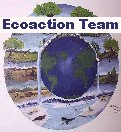CT Earthquake History and Hazards
Read the USGS
article about earthquakes in Connecticut, including the 1790 quake, then answer the following questions.
1. How does our state's seismic activity compare
other US and New England states?
2. What are the Moodus Noises?
3. Describe how nearby strong earthquakes have
affected CT.
Use the New England Seismic Network (NESN) map
of N.E. earthquakes from
1638-1995, and the map of N.E. earthquakes
Oct 1975-Dec 1997 from the NESN article on NE Seismicity to
answer the following questions
4. Calculate the average number of earthquakes
per year from 1638-1995
in CT.
5. Calculate the average number of earthquakes
per year from 1975-1997
in CT.
6. If these numbers are different, explain why
(hint: when was the seismograph invented?).

7. The Seismic
Hazard Map from the US Geological Service shows how much shaking has a 10% chance of happening in the next 50 years. In other words, there is a 10% chance that an earthquake will happen in the next 50 years that will produce the marked amount of shaking. The shaking is measured as a percent of gravity. 15% g means that the ground could move with a force .15 that of the normal wieght of an object. 10% g can knock an un secured house off its foundation.
Describe the level of risk from earthquake damage in our area.
At left is a map of the location of the earthquakes of magnitude 3.0 or greater that occurred near CT from 1638-1998. Click on the map for a full screen version, use back button to return here. This map is a portion of the larger map showing the entire northeast US and nearby Canada that is on the wall in Room 206.
To see information about all the earthquakes recorded in the same area as the map to the left from 1973 to the present, click the following link:
List
of CT area earthquakes 1973-present from the USGS NEIC or use the map at:Recent Earthquake Map. Longitude and latitude can be used to find locations using Terraserver, or the National Map Viewer.
10. From the maps and the earthquake list, list the locations (towns) of 10 earthquakes that have been strong enough to be felt that occurred in your lifetime. You may any of the above maps to locate earthquakes by longitude and latitude since then. Remember that people usually only feel earthquakes with a magnitude of 2.5 and above.
8. Using your REDAS (Resdential
Earthquake Damage Assessment Scale) information and the handout description,
hypothesize about the damage that will occur to EACH section of your house when the most
severe CT earthquake happens again.
9. Using the REDAS information and the handout
description, hypothesis about the damage that will occur to EACH section of Mr. Mitchell's
old house when the most severe CT earthquake happens again.
Some other links: , Why Does the Earth Quake
in New England? from Boston College,
(Return to top of page)






